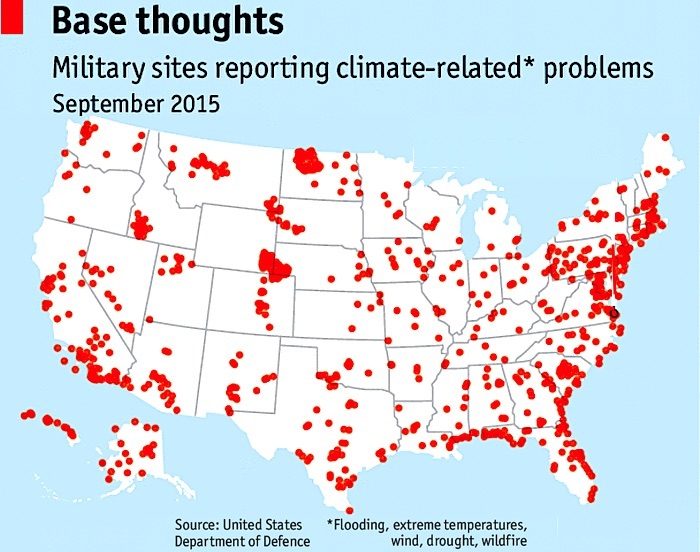
© US Dept. of Defense
The Defense Department issued a
report to Congress Thursday finding that climate change is a "national security" issue that could leave military bases vulnerable to coastal flooding and wildfires fueled by drought.
"The effects of a changing climate are a national security issue with potential impacts to Department of Defense missions, operational plans, and installations," the 22-page report said.
Congress mandated the report in the fiscal year 2018 National Defense Authorization Act,
asking DOD to report on "vulnerabilities to military installations and combatant commander requirements resulting from climate change over the next 20 years."The NDAA also required the Pentagon to report on the top 10 at-risk bases and what should be done to protect them. But the new DOD report to Congress does not provide a list.
Rather,
it reviewed 79 "mission-essential" military installations in the U.S. that could face climate change-related risks within the next 20 years.
DOD found that
53 of those bases face a current risk of repeated flooding because of storm surge fueled by sea level rise, with seven more vulnerable to being inundated in the future.
Most of these are located on the East Coast.It notes that Joint Base Langley-Eustis in Virginia has already experienced 14 inches of sea level rise since 1930.
The report also says
36 military bases are vulnerable to damage from wildfires, with an additional seven facing a future risk of blazes. More than half of the bases could be harmed by drought, which can hamper water supply.
Democrats of the House Armed Services Committee criticized the DOD's report, saying it lacks specific plans on how the military intends to respond to climate change.
"While this climate report acknowledges that nearly all the military installations it studied are vulnerable to major climate change impacts, it fails to even minimally discuss a mitigation plan to address the vulnerabilities." said Rep. Adam Smith, D-Wash., the committee's chairman.
DOD says the results of the study have emphasized its
ongoing push to incorporate climate change resilience as part of its planning and decision-making process for operating current bases and building new ones.
The latest NDAA for fiscal year 2019, signed by President Trump in August, directs the military to include in every installation's master plan an examination of "energy and climate resilience."
It defines climate resilience as "anticipation, preparation for, and adaptation to utility disruptions and changing environmental conditions and the ability to withstand, respond to, and recover rapidly from utility disruptions while ensuring the sustainment of mission-critical operations."The push by Congress, and the Pentagon, to consider the risks of climate change to the military
contradicts the actions of Trump.Trump, shortly after taking office, revoked a memo that former President Barack Obama signed in 2016, directing the Defense Department to consider climate change in its decisions about where to build new installations and prepare for future threats.
Comment: See also:
Military contractors see extreme weather civil unrest as good for business